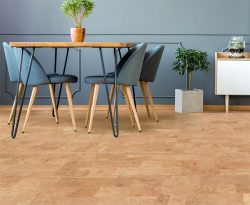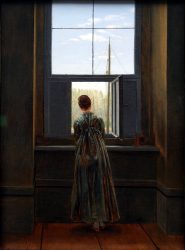
During stay-at-home orders, I’ve contemplated how the pandemic might change home design. Although Medieval castles with deep moats and stone ramparts come to mind when watching the news. Will this tragic pandemic actually change our homebuilding behaviors? It just might in subtle ways.
Surfaces
Building finishes constantly change with the winds of fashion. So trends in surfaces could easily respond to the pandemic. Ironically, stainless steel was adopted for it’s industrial look and apparent hygienic properties, being easily cleaned. But scientists now know stainless surfaces are biologically inert, allowing coronavirus to live for several days. Plastic has the same problem.
 There’s a reason our ancestors chose bronze and brass for building hardware and fixtures. Copper and it’s alloys are naturally antimicrobial. Recent tests show coronavirus and other microbes can’t live on these surfaces long, dying off within hours. Past cultures, at least back to ancient Egypt, harnessed copper’s properties for health. Water jugs and watering cans were made from copper alloys because they keep water pure. Copper coins were placed in cisterns for the same reason. Even today’s homes largely utilize copper plumbing. While we may not throw pennies into sport bottles. A resurgence of bronze knobs and brass fixtures seems likely.
There’s a reason our ancestors chose bronze and brass for building hardware and fixtures. Copper and it’s alloys are naturally antimicrobial. Recent tests show coronavirus and other microbes can’t live on these surfaces long, dying off within hours. Past cultures, at least back to ancient Egypt, harnessed copper’s properties for health. Water jugs and watering cans were made from copper alloys because they keep water pure. Copper coins were placed in cisterns for the same reason. Even today’s homes largely utilize copper plumbing. While we may not throw pennies into sport bottles. A resurgence of bronze knobs and brass fixtures seems likely.
For the wealthy, a unique upgrade may become silver or silver plated bronze. Silver nitrate is still an anti-infection ointment. Like copper, microbes can’t easily live on silver surfaces. Because of it’s high cost, silver won’t gain wide spread use. But silver could become an interesting choice for conspicuous consumption, as in the past.
 Cork flooring is much like copper. Cork, used for centuries as a wine bottle plug, has a waxy substance called suberin which repels small vermin, insects and microbes. Although cork wasn’t used for flooring until the late 1800’s in Spain and Portugal. This modern product may see a spike in popularity. Still, hard flooring surfaces will likely stay in favor because of their durability and cleaning ease. While carpet will continue it’s slide into unpopularity. In favor of removable area rugs over hard flooring.
Cork flooring is much like copper. Cork, used for centuries as a wine bottle plug, has a waxy substance called suberin which repels small vermin, insects and microbes. Although cork wasn’t used for flooring until the late 1800’s in Spain and Portugal. This modern product may see a spike in popularity. Still, hard flooring surfaces will likely stay in favor because of their durability and cleaning ease. While carpet will continue it’s slide into unpopularity. In favor of removable area rugs over hard flooring.
Recent technology trends include suspended copper particles and other virus killing chemicals in coatings. These antimicrobial coatings have become popular in hospitals. They could expand to our home’s high touch surfaces, including knobs, fixtures, counters, walls and HVAC systems.
The texture of knobs and other hardware could be altered for safety. Elena Ivanova, a molecular biochemist at RMIT University in Australia, and others are experimenting with lazer etched surfaces that shed viruses. Their research is preliminary but shows promise.
Would anyone be surprised if future building finishes and textures are chosen with antimicrobial properties in mind? Even the least allergic and most skeptical home dwellers may now take notice, accelerating healthy home trends and hygienic building products.
Ventilation
Researchers believe the virus spreads in enclosed spaces approximately 15 times more easily than outdoors. One study by Leslie Dietz, et al., showed how some restaurant air conditioners spread the virus among patrons that were not in close contact. This same study suggests it’s better for AC to include outside air instead of only recirculating inside air. They suggest not using AC at all is safest, especially if natural ventilation is available.
V entilation and healthy HVAC features will likely become a hot buttons for homeowners. If so, rooms with cross ventilation and big windows will become more valuable. So will HVAC systems with outside air intake, heat exchangers and vented zones. Forced air may become less popular in some climates.
entilation and healthy HVAC features will likely become a hot buttons for homeowners. If so, rooms with cross ventilation and big windows will become more valuable. So will HVAC systems with outside air intake, heat exchangers and vented zones. Forced air may become less popular in some climates.
For shared housing, occupants won’t want to share air conditioning. In general, allowing bedrooms and other living areas to be independently vented if someone in the family gets sick makes sense too. Although there’s no evidence yet air purifiers and HEPA filters stop infection. They may become popular.
Light
No solid evidence exists that the low levels of UV light from the sun has a dramatic effect on coronavirus. But studies confirm daylight is a weak, even practical disinfectant in some settings. For this reason sunlight is used to purify drinking water in countries including India, Kenya and Peru. Even if the effects are weak, it’s possible homeowners will focus on natural light and large windows. Especially when coupled with the ventilation benefits.
As for home UV-C sterilization machines? They’re used in hospital and lab settings, with options available for home use. Please keep in mind UV-C light is dangerous to humans, so has limited home application. Although a close relative on the electromagnetic spectrum, far-UVC, appears safer in low doses and shows promise as a disinfectant.
Increase Humidity & Temperature
Studies show viruses likes cool dry air. Dietz’s study indicates neither coronavirus or influenza like humidity above 40%. Just don’t crank the humidity above 80%, which promotes mold growth, she warns. Higher air temperature also kill viruses more quickly. Virus inactivation is faster at 68 degrees than 40 degrees according to one study. Combining higher temperature with more humidity becomes synergistic for killing the virus. Many home HVAC systems today don’t have built in humidifiers, even in dry climates. This may change due to the pandemic.
Fixtures
Brass faucets were mentioned above. But why touch the fixture at all? No touch faucets are common for commercial buildings. After the pandemic, these hi-tech amenities will likely become more common in the home. Other washing conveniences may proliferate, including sinks in entryways and mudrooms. Or outdoor sinks in some climates. And laundry facilities near or within a mudroom, which allows contaminated clothing to be removed and washed before entering the main house.
Commercial kitchen amenities for home cooking may see a resurgence with restaurants on lock down. Why be at the mercy of a chef, when that favorite meal can be cooked at home? Or that complicated latte? Especially when the cost of these treats are factored in. All you need is the right equipment.
With toilet paper shortages, should the pandemic ready bathroom include a bidet? The increased space needs for a separate bidet make retrofitting existing baths problematic. Thankfully, Kohler and Toto both sell toilet – bidet combination fixtures. It beats a hose in the back yard.
Room Layouts Home offices are already popular. With the pandemic, these rooms will probably become even more prevalent. Desired amenities like high speed internet, printing and office supplies might make home offices become larger with closets and cabinets. The desire to have offices separate from family areas may increase the pressure to reduce or remove other less important areas like living and dining rooms. Offices may be grouped with ¾ baths serving as both powder room and a separate sleeping area if a family member gets sick. Also consider the two desk office or even multiple offices and quiet study space for the kids.
Home offices are already popular. With the pandemic, these rooms will probably become even more prevalent. Desired amenities like high speed internet, printing and office supplies might make home offices become larger with closets and cabinets. The desire to have offices separate from family areas may increase the pressure to reduce or remove other less important areas like living and dining rooms. Offices may be grouped with ¾ baths serving as both powder room and a separate sleeping area if a family member gets sick. Also consider the two desk office or even multiple offices and quiet study space for the kids.
Mudrooms are also currently popular. But larger mudrooms with sinks and laundry equipment are bound to become valuable. While mudrooms have been associated with private, family entry. It’s quite possible formal entries might take on more of a mudroom character. Perhaps in smaller homes, the hygienic mudroom and formal entry will be closely situated or combined.
Home gyms are considered a luxury for most. Yet, with fitness centers closing amid trends towards increased healthy living. Exercise rooms will become more important for those with space. For others, equipment will be incorporated into home offices, garages or other space saving approaches. Xfit makes a hidden home gym stuffed inside a modern metal armoire. While Hidden Grove has a fancy wood cabinet version including a desk and entertainment center.
With night life at a standstill, home bars and wine cellars may see a spike in interest. While some rich homeowners will undoubtedly add commercial sized bars overlooking huge media rooms. Most with modest space, like apartment dwellers, will consider adding bar functions to kitchens or closet areas. Hidden bars like the Crosley’s Lafayette Folding Bar or Howard Miller’s Sonoma Hide-A-Bar are literally bars hidden inside a cabinet, to be placed anywhere.
Outdoor Spaces
Perhaps nothing affects us more during this lock down than access to outdoor and community spaces. Because our connection with nature and community is vitally important for health and well being. Most can barely imagine how a resident in New York City, London or Rome feels stuck in an apartment 24/7.
 For apartment dwellers and home owners alike, the balcony may see a resurgence in value. Raised above the crowd at a safe distance, but big enough to get outside. The balcony is an ancient urban response to human needs explains Vittoria Traverso in her BBC article, The History of Balconies. Balconies grace facades in most big cities for good reason.
For apartment dwellers and home owners alike, the balcony may see a resurgence in value. Raised above the crowd at a safe distance, but big enough to get outside. The balcony is an ancient urban response to human needs explains Vittoria Traverso in her BBC article, The History of Balconies. Balconies grace facades in most big cities for good reason.
 Other time honored urban outdoor places providing protection may see renewed interest, including walled yards and courtyards. Both places provide private outdoor space and automatic social distancing. I’m reminded of my youth in New Mexico where many old homes have courtyards surrounded by adobe walls. Low enough to see the neighbors, but high enough to keep them at a distance.
Other time honored urban outdoor places providing protection may see renewed interest, including walled yards and courtyards. Both places provide private outdoor space and automatic social distancing. I’m reminded of my youth in New Mexico where many old homes have courtyards surrounded by adobe walls. Low enough to see the neighbors, but high enough to keep them at a distance.
Image Credits
Castle image by Diliff @ commons.wikimedia.com
Brass Watering Can by Jeltovski @ morguefile.com
Cancork Flooring @ cancork.com
Woman at Window by C.D. Friedrich
Typewriter on Table by Melodi2@morguefile.com
Balconies by TarragonaMurales@commons.wikimedia.com
Adobe wall by Todd Remington
Further Reading
Copper’s Virus-Killing Powers Were Known Even to the Ancients
by Jim Morrison
Smithsonian Magazine, April 14, 2020
Should you turn off your air-conditioning if someone is sick with coronavirus in your home?
by Shira Feder
Business Insider April 27, 2020
2019 Novel Coronavirus (COVID-19) Pandemic: Built Environment Considerations To Reduce Transmission
by Leslie Deitz, et al.
May 11, 2020 American Society of Microbiology.
Why do Balconies Inspire Us?
by Vittoria Traverso
The BBC.com April 10, 2020
The Surfaces that kill bacteria and viruses
by Christine Ro
The BBC.com May 31, 2020